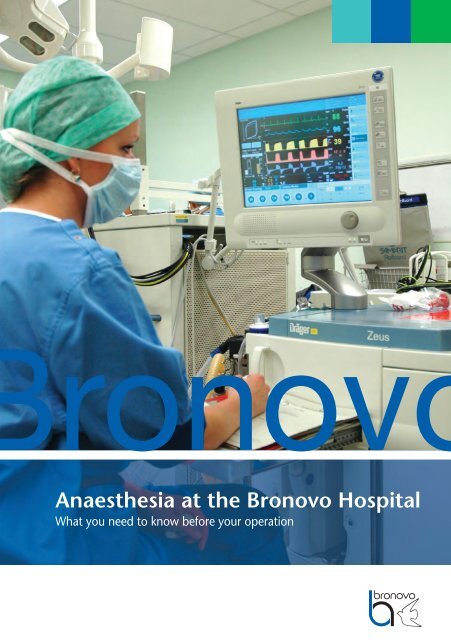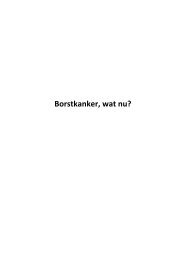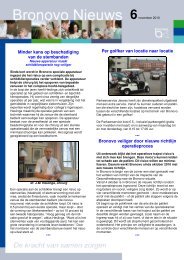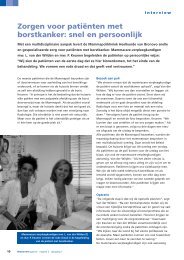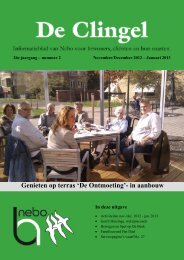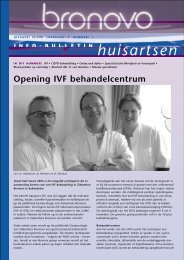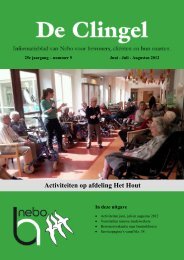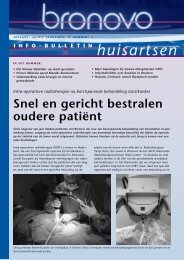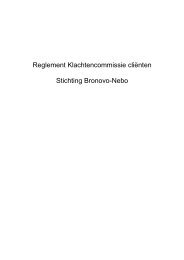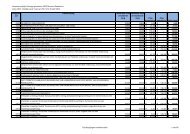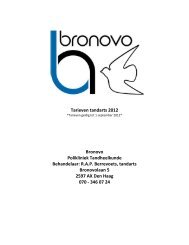Anaesthesia at the Bronovo Hospital
Anaesthesia at the Bronovo Hospital
Anaesthesia at the Bronovo Hospital
- No tags were found...
You also want an ePaper? Increase the reach of your titles
YUMPU automatically turns print PDFs into web optimized ePapers that Google loves.
Published: <strong>Bronovo</strong>-Nebo Found<strong>at</strong>ionPrint run: 2.000 copies, March 2011Graphic Design: Mediaresponse - Gorinchem<strong>Bronovo</strong> has a str<strong>at</strong>egic alliance with LUMC2
This brochure contains inform<strong>at</strong>ion about anaes<strong>the</strong>sia and pain relief duringand after your surgery or examin<strong>at</strong>ion.The inform<strong>at</strong>ion is intended to supplement your convers<strong>at</strong>ion with <strong>the</strong>anaes<strong>the</strong>siologist. If you still have questions, you may phone <strong>the</strong> pre-oper<strong>at</strong>iveoutp<strong>at</strong>ients’ clinic, telephone number 070 – 312 44 56 on working daysfrom 08.00 - 16.30 hours3
TABLE OF CONTENTS<strong>Anaes<strong>the</strong>sia</strong> 5Forms of anaes<strong>the</strong>sia 5General anaes<strong>the</strong>sia 5Regional anaes<strong>the</strong>sia 6The anaes<strong>the</strong>siologist 9The pre-oper<strong>at</strong>ive outp<strong>at</strong>ients’ clinic 9Changes in your health 10Prepar<strong>at</strong>ion for <strong>the</strong> surgery or <strong>the</strong> examin<strong>at</strong>ion 10A good night’s sleep 10Prepar<strong>at</strong>ion <strong>at</strong> home 11Time of admission 11Coming with an empty stomach 11Medic<strong>at</strong>ion use 11Jewellery, make-up etc. 12Admission to <strong>the</strong> nursing ward 12The p<strong>at</strong>ient’s room 12Wh<strong>at</strong> to bring with you 13Contact person 13Visiting hours 13Shaving and clothing for <strong>the</strong> oper<strong>at</strong>ion 13Premedic<strong>at</strong>ion 14The oper<strong>at</strong>ing complex 14The holding area 14The oper<strong>at</strong>ing <strong>the</strong><strong>at</strong>re 14After <strong>the</strong> anaes<strong>the</strong>sia/oper<strong>at</strong>ion 15The recovery room 15Pain 15Your pain score 16Pain relief on a fixed schedule 17Side effects and complic<strong>at</strong>ions of anaes<strong>the</strong>sia 17Back to <strong>the</strong> ward 18Inform<strong>at</strong>ion for p<strong>at</strong>ients who are having surgery as day p<strong>at</strong>ients 19Discharge 19Home again 19Problems and/or questions 20In conclusion 20Arrangements for <strong>the</strong> day of <strong>the</strong> surgery 214
ANAESTHESIA<strong>Anaes<strong>the</strong>sia</strong> is <strong>the</strong> collective name for all types of anaes<strong>the</strong>tics for surgery orexamin<strong>at</strong>ions. It means ‘numbness.’ In practice, however, anaes<strong>the</strong>sia is morethan just numbing. The objective of anaes<strong>the</strong>sia is to keep you in <strong>the</strong> bestpossible condition during <strong>the</strong> surgery.An anaes<strong>the</strong>siologist is a medical doctor who has specialized in <strong>the</strong> variousforms of anaes<strong>the</strong>sia, pain control and o<strong>the</strong>r medical care concerned with<strong>the</strong> oper<strong>at</strong>ion.FORMS OF ANAESTHESIAThere are two forms of anaes<strong>the</strong>sia th<strong>at</strong> are used in surgery, namely:• General anaes<strong>the</strong>sia• Regional anaes<strong>the</strong>sia (extensive localized numbness).A combin<strong>at</strong>ion of both forms of anaes<strong>the</strong>sia is also often used, specifically formajor surgery. Which form of anaes<strong>the</strong>sia is <strong>the</strong> most suitable for you will bedetermined by your anaes<strong>the</strong>siologist in consult<strong>at</strong>ion with you. This dependson various factors such as your age, your physical condition and <strong>the</strong> kind ofsurgery th<strong>at</strong> you are having.General anaes<strong>the</strong>siaWith general anaes<strong>the</strong>sia, your entire body is made numb. Because you aretemporarily unconscious, you will not be aware of anything during <strong>the</strong> surgeryand will also not remember anything about <strong>the</strong> oper<strong>at</strong>ion. The drugs are generallyadministered via an intravenous line. In some cases, you will be given <strong>the</strong> medic<strong>at</strong>ionthrough a mask over your nose and mouth. This is generally <strong>the</strong> case withchildren.If necessary, a tube will be inserted into your thro<strong>at</strong> for bre<strong>at</strong>hing as soon as youare under general anaes<strong>the</strong>sia.5
Regional anaes<strong>the</strong>siaWith regional anaes<strong>the</strong>sia, <strong>the</strong> anaes<strong>the</strong>siologist will only numb th<strong>at</strong> area of <strong>the</strong>body th<strong>at</strong> is to be oper<strong>at</strong>ed on. As long as <strong>the</strong> medic<strong>at</strong>ion is working, you willnot be able to move th<strong>at</strong> part of your body. For an oper<strong>at</strong>ion on your knee, forexample, only <strong>the</strong> lower part of <strong>the</strong> body will be anaes<strong>the</strong>tized. It is sometimesalso possible to anaes<strong>the</strong>tize only <strong>the</strong> leg th<strong>at</strong> is being oper<strong>at</strong>ed on. This isdetermined by <strong>the</strong> anaes<strong>the</strong>siologist who will be taking care of your anaes<strong>the</strong>siaduring <strong>the</strong> oper<strong>at</strong>ion.With this form of anaes<strong>the</strong>sia, you will, in principle, remain awake. The surgicalarea will be screened off so th<strong>at</strong> you will not be able to see <strong>the</strong> oper<strong>at</strong>ion takingplace. If you are worried about consciously experiencing <strong>the</strong> surgery, it is possibleto administer a short acting sleeping medic<strong>at</strong>ion so th<strong>at</strong> you will notice littleor nothing of wh<strong>at</strong> is happening. You may also ask <strong>the</strong> anaes<strong>the</strong>siologist for thisduring <strong>the</strong> procedure.Some forms of regional anaes<strong>the</strong>sia have <strong>the</strong> advantage th<strong>at</strong> after <strong>the</strong> surgery agood painkiller with localized pain medic<strong>at</strong>ion can be given. This is administeredvia a c<strong>at</strong>heter (a tube).A. Regional or plexus anaes<strong>the</strong>sia of shoulder, arm or handFor surgery on a shoulder, an arm or a hand, <strong>the</strong> network of nerves running to<strong>the</strong> arm (brachial plexus) is blocked. The anaes<strong>the</strong>siologist inserts a thin needleinto <strong>the</strong> neck or <strong>the</strong> armpit and stimul<strong>at</strong>es <strong>the</strong> nerve with a minute electricalpulse. When <strong>the</strong> shoulder, arm or hand reacts appropri<strong>at</strong>ely, this needle is <strong>the</strong>nused to administer an anaes<strong>the</strong>tic. The amount and type of anaes<strong>the</strong>tic administereddepends on <strong>the</strong> surgical procedure to be performed and <strong>the</strong> pain levelexpected after <strong>the</strong> surgery. For surgery of less than an hour, <strong>the</strong> anaes<strong>the</strong>tic canalso be administered directly into a vein of <strong>the</strong> hand of <strong>the</strong> arm th<strong>at</strong> will beoper<strong>at</strong>ed on (Bier’s block). An infusion needle is inserted into <strong>the</strong> hand and<strong>the</strong>n an infl<strong>at</strong>able cuff is wrapped around <strong>the</strong> upper arm. After infl<strong>at</strong>ing <strong>the</strong> cuffto fit snugly, <strong>the</strong> anaes<strong>the</strong>tic is injected through <strong>the</strong> infusion needle.The anaes<strong>the</strong>tic will only spread through <strong>the</strong> arm as <strong>the</strong> cuff stops it entering<strong>the</strong> rest of <strong>the</strong> body. The arm will appear spotty and pale and will becomenumb. After surgery, <strong>the</strong> cuff is removed and normal sens<strong>at</strong>ion returns.B. Regional anaes<strong>the</strong>sia of <strong>the</strong> lower bodyFor surgery of <strong>the</strong> lower body, such as <strong>the</strong> genitalia, groin, hips or legs, a nerveblock or a lumbar puncture can be used. A nerve block is applied as described6
The waiting room of <strong>the</strong> pre-oper<strong>at</strong>ive outp<strong>at</strong>ient clinicabove for <strong>the</strong> arms or shoulder, <strong>the</strong> difference being th<strong>at</strong> leg nerves are nowblocked. For a one-leg nerve block during knee surgery, both <strong>the</strong> groin and <strong>the</strong>hip nerves are blocked.For a spinal injection, <strong>the</strong> anaes<strong>the</strong>tic is injected <strong>at</strong> <strong>the</strong> base of <strong>the</strong> spine with afine needle. The effect is almost instantaneous.P<strong>at</strong>ients for major abdominal and thorax surgery are injected in <strong>the</strong> epiduralspace. The anaes<strong>the</strong>tic agent is so administered via a thin tube which remainsin place, taped to <strong>the</strong> p<strong>at</strong>ient’s back where it can be used for fur<strong>the</strong>r pain tre<strong>at</strong>mentafter <strong>the</strong> oper<strong>at</strong>ion.7
Anaes<strong>the</strong>siologist team <strong>Bronovo</strong>.Standing from left to right:F. Kamerling, A.L. Molina, Mrs. K. Groenewoud-Muderlak and N. van der WilkSitting from left to right:R.L. van Leersum, Mrs. S.M. Mulder, W.J. Engelbrecht and Mrs. C.E. Kam-Endtz.8
THE ANAESTHESIOLOGISTYour body must keep functioning well during <strong>the</strong> surgery. The anaes<strong>the</strong>siologistmakes sure th<strong>at</strong> <strong>the</strong> bodily functions remain stable, so th<strong>at</strong> you can comethrough <strong>the</strong> oper<strong>at</strong>ion as well as possible. With <strong>the</strong> aid of special equipment,<strong>the</strong> anaes<strong>the</strong>siologist monitors and regul<strong>at</strong>es such functions as your bloodpressure, heart r<strong>at</strong>e and bre<strong>at</strong>hing. If necessary, he/she can instantly adjust <strong>the</strong>anaes<strong>the</strong>sia.The pre-oper<strong>at</strong>ive outp<strong>at</strong>ients’ clinicThe specialist who is going to perform <strong>the</strong> surgery will give you a questionnaireform, th<strong>at</strong> you must fill in before your appointment <strong>at</strong> <strong>the</strong> pre-oper<strong>at</strong>ive outp<strong>at</strong>ients’clinic. At this clinic of <strong>the</strong> Anaes<strong>the</strong>siology Department, you will have aninitial consult<strong>at</strong>ion with a nurse. The nurse will measure your blood pressure,determine your height and weight and possibly make an ECG(Electrocardiogram), depending on your age and <strong>the</strong> st<strong>at</strong>e of your health.The nurse will also give you inform<strong>at</strong>ion about <strong>the</strong> procedures before andduring your admission.After this, you will have a consult<strong>at</strong>ion with <strong>the</strong> anaes<strong>the</strong>siologist who will assessyour physical condition and make a risk-assessment for <strong>the</strong> oper<strong>at</strong>ion. Based onyour answers to <strong>the</strong> questionnaire, <strong>the</strong> anaes<strong>the</strong>siologist may ask you for moreinform<strong>at</strong>ion. Depending upon your personal situ<strong>at</strong>ion, <strong>the</strong> anaes<strong>the</strong>siologistmay decide to request additional testing, such as an X-ray or a blood test.If necessary, he/she will refer you to ano<strong>the</strong>r specialist. All this is to ensure th<strong>at</strong>you are in an optimal condition before <strong>the</strong> surgery. In discussion with you, <strong>the</strong>anaes<strong>the</strong>siologist will decide wh<strong>at</strong> type of anaes<strong>the</strong>sia (general, regional or acombin<strong>at</strong>ion) you will receive.There are eight doctors working in <strong>the</strong> Anaes<strong>the</strong>siology Department. So youmay receive your anaes<strong>the</strong>sia from a different doctor than <strong>the</strong> one you saw <strong>at</strong><strong>the</strong> outp<strong>at</strong>ients’ clinic. On <strong>the</strong> day of <strong>the</strong> surgery, you will meet <strong>the</strong> anaes<strong>the</strong>siologistwho will be responsible for your anaes<strong>the</strong>sia. This anaes<strong>the</strong>siologist willadhere to <strong>the</strong> agreements th<strong>at</strong> were made concerning <strong>the</strong> anaes<strong>the</strong>sic techniqueto be used, unless <strong>the</strong>re have been changes in your health, <strong>the</strong> proposedoper<strong>at</strong>ion has been changed or <strong>the</strong> anaes<strong>the</strong>siologist is convinced th<strong>at</strong> adifferent anaes<strong>the</strong>sic technique will be safer for you.The consulting anaes<strong>the</strong>siologist will first discuss this with you.9
In principle, <strong>the</strong> visit to <strong>the</strong> pre-oper<strong>at</strong>ive outp<strong>at</strong>ients’ clinic is valid for sixmonths. If <strong>the</strong> waiting time for your oper<strong>at</strong>ion is longer, you will be contactedby <strong>the</strong> pre-oper<strong>at</strong>ive outp<strong>at</strong>ients’ clinic before your admission. Depending uponyour physical condition, it will be determined whe<strong>the</strong>r or not you must visit <strong>the</strong>outp<strong>at</strong>ients’ clinic again or if a few questions over <strong>the</strong> telephone are sufficient.CHANGES IN YOUR HEALTHThere may be some time between your visit to <strong>the</strong> outp<strong>at</strong>ients’ clinic and <strong>the</strong>moment th<strong>at</strong> you are called in for your surgery. If, during this time, <strong>the</strong>re havebeen any changes in your general health, you must report this to <strong>the</strong> consultinganaes<strong>the</strong>siologist in <strong>the</strong> pre-oper<strong>at</strong>ive outp<strong>at</strong>ients’ clinic so th<strong>at</strong> this can betaken into account (telephone pre-oper<strong>at</strong>ive outp<strong>at</strong>ients’ clinic: 070 - 312 44 56).This could include any of <strong>the</strong> following:• If you have been tre<strong>at</strong>ed by a different medical specialist;• If changes have been made in your medic<strong>at</strong>ion;• If your blood pressure is higher;• If you have any wounds or infections on your skin in <strong>the</strong> area th<strong>at</strong> is to beoper<strong>at</strong>ed on;• If you have been admitted to a hospital, in <strong>Bronovo</strong> <strong>Hospital</strong> or elsewhere• If you have had surgery• For women: if you are pregnant or think th<strong>at</strong> you might be.If, on <strong>the</strong> day preceding or <strong>the</strong> day of your surgery, you develop a fever (38.5°Cor higher) or a serious cold, it is important to pass on this inform<strong>at</strong>ion immedi<strong>at</strong>ely,by phone to <strong>the</strong> specialist who is going to do <strong>the</strong> surgery. In th<strong>at</strong> case, itwill be decided, in consult<strong>at</strong>ion with <strong>the</strong> anaes<strong>the</strong>siologist, whe<strong>the</strong>r or not <strong>the</strong>surgery can take place.PREPARATION FOR THE SURGERY OR THE EXAMINATIONA good night’s sleepIt is important th<strong>at</strong> you are well rested on <strong>the</strong> day of <strong>the</strong> surgery. Perhaps youare a bit nervous or <strong>the</strong> strange hospital environment (if you have already beenadmitted) is keeping you awake. In th<strong>at</strong> case, you may ask <strong>the</strong> nursing staff fora sleeping pill.10
PREPARATION AT HOMETime of admissionIf you are being admitted to <strong>the</strong> hospital on <strong>the</strong> day of <strong>the</strong> surgery, you mustcall <strong>the</strong> Admissions Office telephone number: (070 - 312 46 82) between14.00 and 16.00 hours one working day before <strong>the</strong> planned surgery in order toinquire about <strong>the</strong> time th<strong>at</strong> you are expected <strong>at</strong> <strong>the</strong> hospital. The actual time of<strong>the</strong> oper<strong>at</strong>ion itself cannot be given. You will hear about this once you areadmitted.P<strong>at</strong>ients who are to be admitted one or more days before <strong>the</strong> surgery willreceive a phone call about this from <strong>the</strong> relevant outp<strong>at</strong>ients’ clinic or via <strong>the</strong>Admissions Office.Coming with an empty stomachThe oper<strong>at</strong>ion can only be done if you have fasted in <strong>the</strong> hours beforehand.This is to prevent severe complic<strong>at</strong>ions.From five hours before <strong>the</strong> agreed admittance time, you may not e<strong>at</strong> ordrink anything except clear liquids like:• w<strong>at</strong>er;• coffee and tea without milk or creamer;• fruit cordial diluted with w<strong>at</strong>er;• apple juice.These drinks may be drunk until one hour before <strong>the</strong> admittance time.It is not allowed to smoke on <strong>the</strong> day of <strong>the</strong> oper<strong>at</strong>ion.Medic<strong>at</strong>ion useIn most cases, you should continue to take your own medic<strong>at</strong>ion up until <strong>the</strong>surgery. The anaes<strong>the</strong>siologist will determine wh<strong>at</strong> you may or may not take.If you are taking diuretics, you may not take <strong>the</strong>m on <strong>the</strong> morning of <strong>the</strong>oper<strong>at</strong>ion.The use of aspirin and blood thinning medic<strong>at</strong>ion (Sintrommitis,Fenprocoumon, Acenocoumarol, Marcoumar, Ascal, Plavix or Persantin) mustbe stopped <strong>at</strong> least 5 days -- but generally 10 days -- before <strong>the</strong> oper<strong>at</strong>ion,unless <strong>the</strong> anaes<strong>the</strong>siologist or your specialist has decided differently in your11
case. This is in connection with <strong>the</strong> effect of <strong>the</strong>se medicines on <strong>the</strong> clotting of<strong>the</strong> blood.The use of painkillers such as Brufen, Voltaren and o<strong>the</strong>rs must be stopped1 day before <strong>the</strong> surgery. If you are in pain, you may use paracetamol up to <strong>the</strong>day of <strong>the</strong> procedure. You may also continue to use e.g. COX-II inhibitors,Arcoxia and Celebrex.Women who are taking birth control pills may continue to take <strong>the</strong>m. After <strong>the</strong>surgery, complete protection can, however, not be guaranteed for <strong>the</strong> remainderof <strong>the</strong> cycle.Jewellery, make-up etc.Before <strong>the</strong> procedure, you must remove all your jewellery. This also applies topiercings in all body parts.Make-up must be removed. This also applies to nail (finger/toe) varnish:<strong>the</strong> anaes<strong>the</strong>siologist will want to be able to see <strong>the</strong> n<strong>at</strong>ural colour of your skinand nails.If your procedure is going to be done under general anaes<strong>the</strong>sia, you must alsoleave your glasses, contact lenses and dentures -- if applicable -- behind in <strong>the</strong>ward. This is not necessary with regional anaes<strong>the</strong>sia.A hearing aid may generally be taken into <strong>the</strong> oper<strong>at</strong>ing complex if, for example,you would not be able to hear <strong>the</strong> anaes<strong>the</strong>siologist without it and hewould not be able to communic<strong>at</strong>e with you.ADMISSION TO THE NURSING WARDOn <strong>the</strong> day of your procedure, you must report to <strong>the</strong> nursing ward <strong>at</strong> <strong>the</strong>agreed time. This is generally two hours before <strong>the</strong> procedure and never before07.00 hours.The p<strong>at</strong>ient’s roomOn <strong>the</strong> ward, you will be given a bed and a bedside cupboard. There is also alockable wardrobe available for storing your possessions. You can lock thiswardrobe after depositing a 2 euro coin. When you return <strong>the</strong> key, you will getyour coin back.12
In our hospital, it is possible th<strong>at</strong> men and women share one room. If you havefundamental objections to this, you should make this known to <strong>the</strong> AdmissionsOffice.Wh<strong>at</strong> to bring with you?Do not forget to bring <strong>the</strong> following things with you:• Your registr<strong>at</strong>ion card with <strong>the</strong> bar code and appointment card.• The medic<strong>at</strong>ion th<strong>at</strong> you use <strong>at</strong> home and/or a list of <strong>the</strong> medic<strong>at</strong>ion and <strong>the</strong>dosages th<strong>at</strong> you take.• Toilet articles, underwear, nightclo<strong>the</strong>s, a b<strong>at</strong>hrobe and slippers.• Dietary requirements, if applicable.• If desired, magazines, a book or o<strong>the</strong>r reading m<strong>at</strong>erial.• Some small change.• With a regional or local anes<strong>the</strong>sia you can bring a MP3 player to listen tomusic during <strong>the</strong> oper<strong>at</strong>ionWe advise you to leave jewellery and o<strong>the</strong>r valuables <strong>at</strong> home!Contact personMake sure th<strong>at</strong> <strong>the</strong>re is a contact person who can be reached by phone during<strong>the</strong> time th<strong>at</strong> you are in our hospital. Toge<strong>the</strong>r with <strong>the</strong> nursing staff, it will bedecided when <strong>the</strong> contact person can call to ask about your condition andwhen you can be taken home again. It is not possible for your contact person/companionto stay in <strong>the</strong> nursing department during your hospitaliz<strong>at</strong>ion.Visiting hoursThe visiting hours are daily from 15.30 - 16.30 hours and from 18.30 - 19.30hours. On S<strong>at</strong>urdays and Sundays, <strong>the</strong>re is an extra visiting hour from 11.15 -12.15 hours. There are different visiting hours for <strong>the</strong> Pedi<strong>at</strong>ric Department and<strong>the</strong> Intensive Care Unit.Shaving and clothing for <strong>the</strong> oper<strong>at</strong>ionIt is sometimes necessary to shave <strong>the</strong> area where you will have <strong>the</strong> surgery.This will be done in <strong>the</strong> oper<strong>at</strong>ing complex.13
Premedic<strong>at</strong>ionBefore you are taken to <strong>the</strong> oper<strong>at</strong>ing <strong>the</strong><strong>at</strong>re, you will generally be given <strong>the</strong>premedic<strong>at</strong>ion by <strong>the</strong> nurse as instructed by <strong>the</strong> anaes<strong>the</strong>siologist. This includesmedic<strong>at</strong>ion th<strong>at</strong> will sed<strong>at</strong>e you and can make you sleepy, as well as a numberof tablets th<strong>at</strong> are intended to act as painkillers immedi<strong>at</strong>ely after <strong>the</strong> oper<strong>at</strong>ion.THE OPERATING COMPLEXThe oper<strong>at</strong>ing complex consists of three centres: <strong>the</strong> holding area where you arereceived, <strong>the</strong> oper<strong>at</strong>ing <strong>the</strong><strong>at</strong>re where your procedure will be performed and <strong>the</strong>recovery room where you will be intensively monitored after <strong>the</strong> surgery.The holding areaYou will be brought to <strong>the</strong> oper<strong>at</strong>ing complex in your bed. Here, you will bereceived in <strong>the</strong> holding area by an anes<strong>the</strong>siology assistant or a nurse. In thisarea, <strong>the</strong>re will be o<strong>the</strong>r p<strong>at</strong>ients who are waiting for surgery.Generally, one of <strong>the</strong> staff members in <strong>the</strong> holding area will insert an intravenousline into your hand or arm and you will be <strong>at</strong>tached to equipment th<strong>at</strong> willmeasure, among o<strong>the</strong>r things, your heart r<strong>at</strong>e and blood pressure. If it has beendecided, in consult<strong>at</strong>ion with you, th<strong>at</strong> you are to receive a regional anaes<strong>the</strong>sic,this will be administered in <strong>the</strong> holding area.After this, you will be brought to <strong>the</strong> oper<strong>at</strong>ing <strong>the</strong><strong>at</strong>re in your bed. There youwill be transferred to <strong>the</strong> oper<strong>at</strong>ion table.The oper<strong>at</strong>ing <strong>the</strong><strong>at</strong>reIf you are given general anaes<strong>the</strong>sia you will be put to sleep in <strong>the</strong> oper<strong>at</strong>ing<strong>the</strong><strong>at</strong>re. Because it is cold in <strong>the</strong> oper<strong>at</strong>ing <strong>the</strong><strong>at</strong>re, you will be covered with awarm flannel blanket. In <strong>the</strong> oper<strong>at</strong>ing <strong>the</strong><strong>at</strong>re, you will see various kinds ofequipment. A large surgical lamp hangs above you. Once you are <strong>the</strong>re, youwill again be <strong>at</strong>tached to <strong>the</strong> monitoring equipment. After <strong>the</strong> procedure isover, you will be woken up in <strong>the</strong> oper<strong>at</strong>ing <strong>the</strong><strong>at</strong>re. You will <strong>the</strong>n be takenback to <strong>the</strong> recovery room in bed. After an oper<strong>at</strong>ion with regional anes<strong>the</strong>siayou will also go to <strong>the</strong> recovery room.14
The recovery roomAFTER THE ANAESTHESIAThe recovery roomIn <strong>the</strong> recovery room, you are <strong>at</strong>tended to by specialist nurses. As in <strong>the</strong> oper<strong>at</strong>ing<strong>the</strong><strong>at</strong>re, your heart and respir<strong>at</strong>ion r<strong>at</strong>es and your blood pressure are measuredand recorded frequently. Here too, a special effort is made to prevent not only<strong>the</strong> pain th<strong>at</strong> might occur after surgery (and allevi<strong>at</strong>e it if it occurs) but alsopossible nausea or vomiting after <strong>the</strong> oper<strong>at</strong>ion.As soon as your physical condition allows, you will be taken back to <strong>the</strong> ward,where <strong>the</strong> unit nurse will receive all your personal inform<strong>at</strong>ion. Occasionally,you might have to be monitored for a little longer, in which case you will betransferred to <strong>the</strong> Intensive Care unit usually for one night.PainIrrespective of <strong>the</strong> scope of <strong>the</strong> surgery, everyone hopes for a quick recovery. Toth<strong>at</strong> end, effective pain relief can be very helpful. For instance, after surgery it isimportant th<strong>at</strong> you continue inhaling and exhaling deeply and are able to coughup and move. Post-surgical pain keeps you from doing so and stops you15
elaxing. In a situ<strong>at</strong>ion like this, pain actually impedes your recovery and,consequently, needs to be relieved. To do so, several possibilities exist: it can betre<strong>at</strong>ed with pills, suppositories, injections or o<strong>the</strong>r methods prescribed by <strong>the</strong>anaesthiologist.Your pain scoreFor good pain relief, it is important for us to know how much pain you areexperiencing. Your input is important for this. You are <strong>the</strong> one feeling <strong>the</strong> painand only you can say how bad it really is.For th<strong>at</strong> reason, pain registr<strong>at</strong>ion is used. For you, this means th<strong>at</strong> after yoursurgery, nurses and doctors will frequently ask you for a pain score. In order todo so, a ‘pain index’ has been developed which is a sort of ’pain <strong>the</strong>rmometer’.In <strong>the</strong> first days after surgery, you will be asked 3 or 4 times daily to indic<strong>at</strong>e<strong>the</strong> level of pain you are experiencing. You will be asked to ’score’ your pain ona scale between 0 (no pain) and 10 (<strong>the</strong> most excruci<strong>at</strong>ing pain).• If you are pain-free, your score would be 0.• If you are experiencing little pain, a number between 1 and 4 would beappropri<strong>at</strong>e. The number 4 is for <strong>the</strong> most pain th<strong>at</strong> is acceptable: remember,surgery is never totally painless. Up to and including, 4, <strong>the</strong> pain is considered“bearable”. Moving, coughing, inhaling and exhaling should not be affected.• Pain scores above 4 are a reason to intervene. You need to report this to yournurse immedi<strong>at</strong>ely so extra medic<strong>at</strong>ion can be given.• A pain score of 10 is for <strong>the</strong> most excruci<strong>at</strong>ing pain you can imagine.This really should not ever happen to you.Pain is a personal experience. If, for instance, you think your pain score is 5,<strong>the</strong>n give it a 5 even though you might think somebody else might give it a 3or a 7. You can never choose a wrong score. After all, it is <strong>the</strong> pain YOU areexperiencing!ImportantIt is important th<strong>at</strong> you inform <strong>the</strong> nurse and <strong>the</strong> doctor about <strong>the</strong> pain you areexperiencing and whe<strong>the</strong>r <strong>the</strong> painkillers are working well. If needed, <strong>the</strong>y cangive you different painkillers or adjust <strong>the</strong> dose. The longer you wait beforereporting <strong>the</strong> uncomfortable pain, <strong>the</strong> harder it will be to tre<strong>at</strong> it. So, please donot try to be ‘brave’!16
Pain relief on a fixed scheduleImmedi<strong>at</strong>ely after surgery you will receive painkillers <strong>at</strong> set times. Administeringpainkillers this way has a continuous soothing effect and is <strong>the</strong> basic principle ofpain tre<strong>at</strong>ment.Depending on your situ<strong>at</strong>ion, different kinds of painkillers can be given:• Paracetamol (acetaminophen) has painkilling and fever-reducing effects but doesnot act as an anti-inflamm<strong>at</strong>ory drug.• Diclofenac not only relieves pain but is also a fever-reducing and anti-inflamm<strong>at</strong>oryagent and is <strong>the</strong>refore not only prescribed for pain relief. This drug can begiven in combin<strong>at</strong>ion with gastro-protective medic<strong>at</strong>ion.• Morphine is a potent painkiller and is not addictive if it is prescribed for shortperiods. There is no reason to be afraid of receiving an overdose.The dur<strong>at</strong>ion of pain depends on <strong>the</strong> kind of surgery received. After administr<strong>at</strong>ionof a painkiller, it is important to determine in which way you, <strong>the</strong> p<strong>at</strong>ient, react to<strong>the</strong> medic<strong>at</strong>ion received. Is <strong>the</strong> medic<strong>at</strong>ion received sufficient or is a higher doserequired? A check is made to see whe<strong>the</strong>r <strong>the</strong> medic<strong>at</strong>ion received is doing its job.Side effects and complic<strong>at</strong>ions of anaes<strong>the</strong>siaNo surgery is entirely risk-free. With proper monitoring devices and a qualifiedstaff, we do our best to ensure your safety and wellbeing before and aftersurgery. Never<strong>the</strong>less, we want to draw your <strong>at</strong>tention to potential side effectsand complic<strong>at</strong>ions:During general anaes<strong>the</strong>sia• allergic reactions to <strong>the</strong> medic<strong>at</strong>ion• damage to teeth or thro<strong>at</strong> caused by insertion of <strong>the</strong> bre<strong>at</strong>hing tube• calamities caused by <strong>the</strong> physical condition of <strong>the</strong> p<strong>at</strong>ient.After recovery from general anaes<strong>the</strong>sia• drowsiness• pain in <strong>the</strong> part of <strong>the</strong> body th<strong>at</strong> was oper<strong>at</strong>ed on.• nausea and/or vomiting• dry thro<strong>at</strong> or sore thro<strong>at</strong> because of insertion of <strong>the</strong> bre<strong>at</strong>hing tube.This irrit<strong>at</strong>ion will disappear within a few days.17
During spinal or epidural anaes<strong>the</strong>sia• insufficient pain relief• low blood pressure• <strong>the</strong> level of numbness may ascend in <strong>the</strong> body, resulting in a feeling ofbre<strong>at</strong>hlessness• difficulty in urin<strong>at</strong>ing.After spinal or epidural anaes<strong>the</strong>sia has lost its effect:• back pain (complaints decrease within a few days)• headaches (complaints decrease by lying fl<strong>at</strong>). If <strong>the</strong>se are very intense orpersist for a long time, you can ask <strong>the</strong> nurse to contact <strong>the</strong> Anaes<strong>the</strong>siologyDepartment.During <strong>the</strong> plexus anaes<strong>the</strong>sia:• insufficient pain relief• allergic reaction to <strong>the</strong> anaes<strong>the</strong>tic.After <strong>the</strong> plexus anaes<strong>the</strong>sia:• tingling sens<strong>at</strong>ions or impaired feeling in arm and/or hand (usually disappearsafter a few days).Fortun<strong>at</strong>ely, serious complic<strong>at</strong>ions are rare. These are almost always <strong>the</strong> consequenceof a very rare calamity or are rel<strong>at</strong>ed to <strong>the</strong> st<strong>at</strong>e of health you were inbefore <strong>the</strong> surgery. Do not hesit<strong>at</strong>e to ask your anaes<strong>the</strong>siologist about <strong>the</strong> risksin your particular case.BACK TO THE WARDWhen you are sufficiently recovered from <strong>the</strong> anaes<strong>the</strong>sia, you will be takenback to <strong>the</strong> ward. If, after <strong>the</strong> surgery, you need extra monitoring and/or tre<strong>at</strong>ment,you will be admitted to <strong>the</strong> Intensive Care Unit. You will have been toldabout this beforehand by <strong>the</strong> anaes<strong>the</strong>siologist or <strong>the</strong> surgeon.After surgery, it might take a while for your physical condition to recover completely.You might tire or feel bre<strong>at</strong>hless more easily. This is quite normal:because of <strong>the</strong> surgery, your body has suffered quite a bit. Complaints like lossof concentr<strong>at</strong>ion and memory will disappear <strong>the</strong> moment you regain your18
strength. Generally, after more extensive and sustained surgery, <strong>the</strong>se complaintslast longer.INFORMATION FOR PATIENTS WHO ARE RECEIVING SURGERY ASDAY PATIENTSA DAY SURGERY admittance means th<strong>at</strong> you will be admitted,oper<strong>at</strong>ed on and sent home all in <strong>the</strong> same day.In addition to <strong>the</strong> inform<strong>at</strong>ion already presented in this brochure, <strong>the</strong> followingapplies to your situ<strong>at</strong>ion:DischargeIn <strong>the</strong> course of <strong>the</strong> day, it will be decided if you have sufficiently recovered from<strong>the</strong> procedure. After your consulting physician or <strong>the</strong> ward doctor has seen you,it will be decided in consult<strong>at</strong>ion with <strong>the</strong> nurse when you may be taken home.The nurse will make an appointment for you for <strong>the</strong> first check-up <strong>at</strong> <strong>the</strong> outp<strong>at</strong>ients’clinic.The specialist will give you a letter for your family doctor (G.P.) and, if necessary,a prescription for medic<strong>at</strong>ion.You must not leave <strong>the</strong> hospital unacccompied nor may you drive yourself.Home again• For <strong>the</strong> first 24 hours after <strong>the</strong> procedure, you may not drive a vehicle or ridea bicycle. This means th<strong>at</strong> you must organize transport<strong>at</strong>ion to go home from<strong>the</strong> hospital.• We advise you to make sure th<strong>at</strong> you are not alone <strong>at</strong> home for <strong>the</strong> first 24hours.• It is also not permitted to oper<strong>at</strong>e machinery (drills, electric saws, etc.) for <strong>the</strong>first 24 hours.• We advise you not to make any important decisions and/or undertake any(business) transactions during this period.• You must not use any alcohol or drugs during <strong>the</strong> first 24 hours after <strong>the</strong>oper<strong>at</strong>ion19
If regional anaes<strong>the</strong>sia of <strong>the</strong> arm was used during your surgery, you will haveto be extra careful with your arm during <strong>the</strong> first day as <strong>the</strong> sens<strong>at</strong>ion takestime to return completely (At least 12 hours). Carry your arm in a sling.If you had surgery while anaes<strong>the</strong>tised by a lumbar puncture and, after returninghome, you notice th<strong>at</strong> your leg muscles feel weak or th<strong>at</strong> parts of yourlegs feel numb again, you must immedi<strong>at</strong>ely contact <strong>the</strong> anaes<strong>the</strong>siologistwhose phone number is listed below.We recommend you to keep a stock of paracetamol 500 mg (acetaminophen)tablets and diclofenac (50 mg) or suppositories <strong>at</strong> home, just in case you startexperiencing pain again. The doctor tre<strong>at</strong>ing you will inform you about dosageand frequency of useProblems and/or questions:After returning home from surgery, you might have problems or questions concerning<strong>the</strong> anaes<strong>the</strong>sia, such as pain relief, complaints about serious headachesafter a spinal anaes<strong>the</strong>sia and <strong>the</strong> occurrence, and control, of nausea and vomiting.If so, please contact <strong>the</strong> Anaes<strong>the</strong>siology Outp<strong>at</strong>ient Department: weekdaysbetween 07.30 and 16.30 hrs, phone number 070 - 312 44 56.After hours, contact <strong>the</strong> anaes<strong>the</strong>siologist on duty through <strong>the</strong> central hospitalphone number: 070 - 312 41 41.IN CONCLUSIONWe hope th<strong>at</strong>, after <strong>the</strong> oper<strong>at</strong>ion, you will be s<strong>at</strong>isfied with <strong>the</strong> tre<strong>at</strong>ment th<strong>at</strong>you have received from <strong>the</strong> doctors in <strong>the</strong> Anes<strong>the</strong>siology Department. If youhave any suggestions concerning improvement to <strong>the</strong> care th<strong>at</strong> you receivedand/or <strong>the</strong> contents of this brochure, we would be glad to hear <strong>the</strong>m.<strong>Bronovo</strong> <strong>Hospital</strong><strong>Bronovo</strong>laan 52597 AX The HagueTel. 070 - 312 41 41www.bronovo.nl20Published: March 2011
ARRANGEMENTS FOR THE DAY OF THE PROCEDUREPlease bring with you all medic<strong>at</strong>ion th<strong>at</strong> you are taking when you are admitted.On <strong>the</strong> day of <strong>the</strong> procedure, you must only take <strong>the</strong> medic<strong>at</strong>ion listed below:_______________________________________________________________________________________________________________________________________________________________________________________________________________________________________________________________________________________________________________________________________________________________________________________________________________________________________________________________________________________________________________________________________________________________________________________________________________________________________________________________Do not take any o<strong>the</strong>r medic<strong>at</strong>ion.You use as blood thinning medic<strong>at</strong>ionMarcoumar (Fenprocoumon)Sintrom(itis) (Acenocoumarol)AscalPlavixo<strong>the</strong>r ………….……………..........You must stop taking this ….. days before <strong>the</strong> oper<strong>at</strong>ion.21
22NOTES
NOTES23
24<strong>Bronovo</strong> <strong>Hospital</strong><strong>Bronovo</strong>laan 52597 AX The HagueTel. 070 - 312 41 41www.bronovo.nl
In this brochure, you can read everything about <strong>the</strong> anaes<strong>the</strong>sia th<strong>at</strong> youwill be given during your oper<strong>at</strong>ion or diagnostic procedure.If you still have questions, you may phone <strong>the</strong> pre-oper<strong>at</strong>ive outp<strong>at</strong>ientclinic, telephone number 070 - 312 44 56 on weekdays from08:00 - 16.30 hours.Health Centre Wassenaar, <strong>Bronovo</strong> <strong>Hospital</strong> and Nebo Nursing Home toge<strong>the</strong>r make up<strong>the</strong> <strong>Bronovo</strong>-Nebo Found<strong>at</strong>ionB<strong>Bronovo</strong><strong>Bronovo</strong>laan 52597 AX DEN HAAGPhone: 070 - 312 41 41www.bronovo.nl


